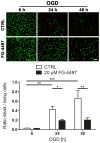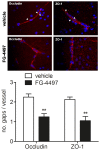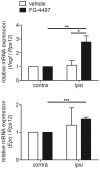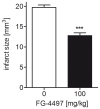Inhibition of HIF prolyl-4-hydroxylases by FG-4497 reduces brain tissue injury and edema formation during ischemic stroke
- PMID: 24409307
- PMCID: PMC3883663
- DOI: 10.1371/journal.pone.0084767
Inhibition of HIF prolyl-4-hydroxylases by FG-4497 reduces brain tissue injury and edema formation during ischemic stroke
Abstract
Ischemic stroke results in disruption of the blood-brain barrier (BBB), edema formation and neuronal cell loss. Some neuroprotective factors such as vascular endothelial growth factor (VEGF) favor edema formation, while others such as erythropoietin (Epo) can mitigate it. Both factors are controlled by hypoxia inducible transcription factors (HIF) and the activity of prolyl hydroxylase domain proteins (PHD). We hypothesize that activation of the adaptive hypoxic response by inhibition of PHD results in neuroprotection and prevention of vascular leakage. Mice, subjected to cerebral ischemia, were pre- or post-treated with the novel PHD inhibitor FG-4497. Inhibition of PHD activity resulted in HIF-1α stabilization, increased expression of VEGF and Epo, improved outcome from ischemic stroke and reduced edema formation by maintaining BBB integrity. Additional in vitro studies using brain endothelial cells and primary astrocytes confirmed that FG-4497 induces the HIF signaling pathway, leading to increased VEGF and Epo expression. In an in vitro ischemia model, using combined oxygen and glucose deprivation, FG-4497 promoted the survival of neurons. Furthermore, FG-4497 prevented the ischemia-induced rearrangement and gap formation of the tight junction proteins zonula occludens 1 and occludin, both in cultured endothelial cells and in infarcted brain tissue in vivo. These results indicate that FG-4497 has the potential to prevent cerebral ischemic damage by neuroprotection and prevention of vascular leakage.
Conflict of interest statement
Figures










Similar articles
-
Neuron-specific prolyl-4-hydroxylase domain 2 knockout reduces brain injury after transient cerebral ischemia.Stroke. 2012 Oct;43(10):2748-56. doi: 10.1161/STROKEAHA.112.669598. Epub 2012 Aug 28. Stroke. 2012. PMID: 22933585
-
Erythropoietin inhibits HIF-1α expression via upregulation of PHD-2 transcription and translation in an in vitro model of hypoxia-ischemia.Transl Stroke Res. 2014 Feb;5(1):118-27. doi: 10.1007/s12975-013-0312-z. Epub 2013 Nov 27. Transl Stroke Res. 2014. PMID: 24323731 Free PMC article.
-
The role of HIF in cobalt-induced ischemic tolerance.Neuroscience. 2013 Nov 12;252:420-30. doi: 10.1016/j.neuroscience.2013.07.060. Epub 2013 Aug 3. Neuroscience. 2013. PMID: 23916558
-
The role and regulation of hypoxia-inducible factor-1alpha expression in brain development and neonatal hypoxic-ischemic brain injury.Brain Res Rev. 2009 Dec 11;62(1):99-108. doi: 10.1016/j.brainresrev.2009.09.006. Epub 2009 Sep 25. Brain Res Rev. 2009. PMID: 19786048 Review.
-
HIF-prolyl hydroxylases and cardiovascular diseases.Toxicol Mech Methods. 2012 Jun;22(5):347-58. doi: 10.3109/15376516.2012.673088. Toxicol Mech Methods. 2012. PMID: 22424133 Review.
Cited by
-
Identification of autophagy signaling network that contributes to stroke in the ischemic rodent brain via gene expression.Neurosci Bull. 2015 Aug;31(4):480-90. doi: 10.1007/s12264-015-1547-3. Epub 2015 Aug 8. Neurosci Bull. 2015. PMID: 26254060 Free PMC article.
-
Now a Nobel gas: oxygen.Pflugers Arch. 2019 Dec;471(11-12):1343-1358. doi: 10.1007/s00424-019-02334-8. Epub 2019 Nov 22. Pflugers Arch. 2019. PMID: 31754831 Review.
-
Structure-Activity Relationships and Transcriptomic Analysis of Hypoxia-Inducible Factor Prolyl Hydroxylase Inhibitors.Antioxidants (Basel). 2022 Jan 24;11(2):220. doi: 10.3390/antiox11020220. Antioxidants (Basel). 2022. PMID: 35204103 Free PMC article.
-
HIF‑1α attenuates neuronal apoptosis by upregulating EPO expression following cerebral ischemia‑reperfusion injury in a rat MCAO model.Int J Mol Med. 2020 Apr;45(4):1027-1036. doi: 10.3892/ijmm.2020.4480. Epub 2020 Jan 28. Int J Mol Med. 2020. PMID: 32124933 Free PMC article.
-
Hypoxia Mimetic Agents for Ischemic Stroke.Front Cell Dev Biol. 2019 Jan 8;6:175. doi: 10.3389/fcell.2018.00175. eCollection 2018. Front Cell Dev Biol. 2019. PMID: 30671433 Free PMC article. Review.
References
-
- Dirnagl U, Iadecola C, Moskowitz MA (1999) Pathobiology of ischaemic stroke: an integrated view. Trends Neurosci 22: 391–397. - PubMed
-
- Gelderblom M, Leypoldt F, Steinbach K, Behrens D, Choe CU, et al. (2009) Temporal and spatial dynamics of cerebral immune cell accumulation in stroke. Stroke 40: 1849–1857. - PubMed
-
- Sandoval KE, Witt KA (2008) Blood-brain barrier tight junction permeability and ischemic stroke. Neurobiol Dis 32: 200–219. - PubMed
Publication types
MeSH terms
Substances
LinkOut - more resources
Full Text Sources
Other Literature Sources
Medical
Research Materials
Miscellaneous

